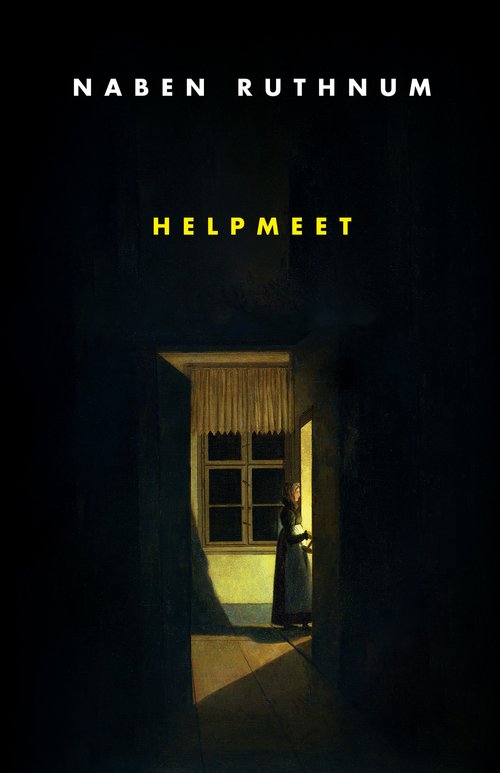Novellas are seeing a resurgence in popularity in horror publishing, and for good reason. Sometimes you’re too busy to commit to a 600-page novel or you need a palate cleanser after scarfing down the aforementioned unnamed 600-page novel. Regardless of your reasoning, novellas are a great way to work the gothic into your busy schedule. One gothic novella that you should definitely add to your to be read pile is Helpmeet by Naben Ruthnum. Coming in at 94 pages, it can be read in a couple of hours, yet it leaves a marked impact and is a sumptuous and grotesque meditation on romance and devotion.
Edward Wilk is ill; that’s for sure. The once vivacious doctor has been reduced to a desiccated husk, different body parts falling off of him as his condition worsens. (Spoiler alert: His penis was the first to go, if you were wondering.) His beloved wife, Louise, is his caregiver, tasked with dosing him with morphine and keeping him comfortable. Her deep and unwavering love for Edward keeps her by his side through his harrowing transformation. Edward soon decides that he wants to end his days at his family’s cottage and apple orchard. Louise obliges, making sure that her husband’s final wishes are carried out. As the secrets behind Edward’s illness are slowly revealed Louise realizes that her husband is changing…possibly into something else, and her love and devotion will be the stalwart force that holds the two together.
Ruthnum seamlessly blends gothic and body horror with a dash of cosmic horror to create a novella that is both rich in terror and romance. At its core, this is a love story. Louise and Edward’s bond is unique and without spoiling too much, the relationship and the exploration of guilt, shame, and classism is brilliantly delineated. It has shades of Daphne du Maurier’s Rebecca and Sarah Waters’s The Little Stranger, taking societal issues to task but in a more subtle way. You can tell Ruthnum is well-versed in the gothic and doesn’t shy away from continuing to mine and create greater understanding of thematic issues that have been previously explored.
He also doesn’t shy away from the romance aspect which in turn deepens the idea of horror at hand. There is the horror of Edward quite literally falling apart, but there is the horror of Louise bearing witness to it all. In the canon of caregiver centric horror it is often emphasized that there is terror in the idea of watching someone in the final throes of life or in the grip of a devastating illness. Louise fears losing her husband more than she fears his degrading appearance. Her love for him is wholly unconditional. She doesn’t care what he does as long as he is hers and vice versa. When Louise married Edward, she truly meant for better or for worse and in sickness and in health.
On Edward’s end of it all, he’s wracked with guilt over the possibility of ruining his beloved’s life. This is where the class commentary comes into full swing. It’s easy to see that Edward loves Louise, even though their marriage drifted into the realm of deeply unconventional as Edward attempted to parse through the shame he felt at plucking the lower class Louise from her world and thrusting her into his far more affluent social strata. He accidentally made Louise a pariah upon their marriage and the shame led him to seek comfort through more adulterous and alcoholic means. Ruthnum looks at love in all of its complicated glory, yet he keeps in mind that torrid romance has long been a hallmark of gothic novels.
Again, I am purposefully tiptoeing around plot devices and giving you the barebones to titillate you. This is one of those tales that is better knowing less. Ruthnum’s careful prose pulls readers into Louise and Edward’s turn of the century world, creating a period piece that is textured and interesting. Contemporary gothic period pieces have such wonderful flare, giving writers the tools of hindsight to weave unique and rich tales. Ruthnum slips into the lush prose that the genre is known for with ease and writes with all the terrible beauty he can muster, and trust me, it’s a lot. Many will be put off by the descriptions of Edward’s merciless decay, yet Ruthnum turns the loss of noses, eyes, and various other appendages into singing poetry. This is body horror by the way of the Brontes. He manages to absorb other genres of horror and set them firmly within the gothic framework that he has provided, giving the subgenres the macabre nuance that they need to tell the story.
Not all authors could so beautifully delineate a gothic romantic story in such a short space, but Ruthnum makes it appear effortless. I consume a lot of gothic horror across all media forms. It’s something I am endlessly passionate about. Since reading Helpmeet, I haven’t been able to evict Louise and Edward Wilk from the hallways of my brain. I love the macabre, and I love a great love story. Today love stories are often looked at to be at odds with horror narratives, which is an asinine point of view, but I digress. Ruthnum reaches back to the gothic, a genre that often features romance in a lusty partnership with the concept of terror itself. By turning modern perceptions on their head and breathing new life into subgenres that some claim are outdated or dead, Ruthnum creates one of the most interesting meditations on both love and horror.

Tags: Books, Caspar David Friedrich, Columns, Naben Ruthnum, Undertow Publications, Unearthing the Gothic



No Comments